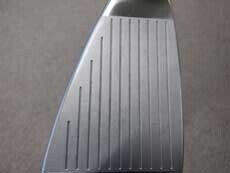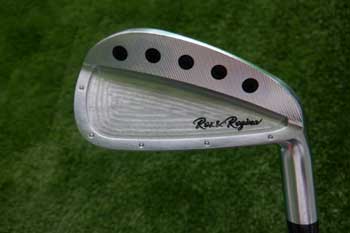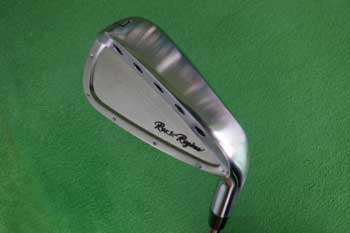EPON AF-906 Review: A Comprehensive Test Hit

Recently, I had the opportunity to test out this golf club.
The club tested was the EPON AF-906.

The shaft is the N.S.PRO MODUS3 HYBRID Graphite On Steel Technology.
The loft is 23 degrees, the club length is 38.75 inches, the shaft flex is S, shaft weight is 90.5g, the balance is D1, torque is 2.9, the kick point is low, and the total weight of the club is 384g.

This is an iron-style utility from EPON.
While many manufacturers focus on hybrid utilities, iron-style utilities are quite rare, and EPON is one of the few manufacturers offering this type.
Though regular hybrids are great, I personally prefer iron and wedge-style clubs over woods, so I really appreciate the iron-style design.
While traditional hybrids are easier to launch the ball, I find iron-style utilities to be more precise and easier when it comes to aiming and shaping shots, giving me a sense of confidence.

Seeing “EPON FORGED by ENDO” on the club always excites me.
Just holding an EPON club brings me great joy.

Iron-style utilities like this one are often elongated in shape.
It’s actually more difficult to find non-elongated designs. When I think of non-elongated iron-style utilities, I immediately think of Srixon, but most others have a more elongated design.
Is it possible that iron-style utilities can be designed with a smaller head? Personally, I feel that a smaller head can make it feel easier to hit.
Larger heads can sometimes cause the face to strike the ball before it has fully returned, resulting in push shots to the right, which has often been a common mistake for me.
Smaller heads usually eliminate the need for lead tape, which is sometimes necessary with larger heads.

The club has a noticeably rounded, hollow structure.
As it’s an iron-style utility, a hollow design is expected, but somewhere in my mind, I still hope for new technologies that don’t rely on hollow designs.

The shape is quite orthodox, clearly showing a hollow construction.
The sole has significant volume, which gives the impression of a low center of gravity.

The topline is slightly thicker, but for an iron-style utility, I consider it quite normal.

The sole is notably wide.
There are various types of sole widths among iron-style utilities, and this one is on the wider side.
I’m sure many people will appreciate this wide sole design.
Even though it’s an iron-style utility, the width of the sole gives the impression that you can use the sole to glide through the ground, similar to a fairway wood or a regular hybrid utility.
I prefer to strike the ball directly from above, but it’s becoming increasingly difficult to find clubs designed for that type of swing.
Based on this view, it seems like tungsten or other weights are not incorporated, but I cannot say for certain.

The entire sole is rounded, making it look like it would glide through the turf easily.
Even on tough lies, such as when the ball is sitting in the grass, it seems like the sole would glide cleanly through without getting stuck.
Both the leading edge and trailing edge are nicely beveled.

The trailing edge has a pronounced curve, showing the low and deep center of gravity.
Many people assume that a deeper center of gravity will make it easier to launch the ball, but this isn’t always the case, especially when striking directly from the ground.
A forward center of gravity with a downward-facing face (increasing loft) can actually result in better spin and better ball control on iron-style shots, which is a feature not typically found in wood-type clubs.
This design may not be to everyone’s taste, but it’s likely in response to strong demand for easier-to-hit clubs.

The neck is on the shorter side, which is typical for iron-style utilities.
Compared to other similar clubs I’ve tested, most had a pronounced hosel, but this one doesn’t have a strong hosel, which I appreciated.
I generally dislike large hosels, wide soles, and strong offsets, so I found this aspect more appealing.

The face features no milling, which is quite standard.
Despite being an EPON, the face here is pretty typical, with no major innovations.
This is more of a classic, traditional design rather than a high-tech club.

The feel during the swing was very good.
I’m using this shaft for the first time, and it was very easy to time, and I immediately felt comfortable with it.

The “Graphite On Steel Technology” is specifically for hybrid shafts.
It seems to combine the steel technology with graphite, which worked quite well for me.
It seems to closely replicate the feel of the MODUS steel shafts, which I’ve always preferred.
I’ve used steel shafts since I first started golf, and I still love them, so I was quite pleased with this shaft’s performance.
The shaft provided a solid feel with no excessive wobbling or instability, making it easy to control.
For clubs that don’t prioritize distance, such as irons, control and stability are more important, and this shaft delivers that perfectly.
The design flexibility with carbon shafts has come a long way, and they’re now widely accepted, even though I still prefer steel.

The EPON branded grip looks great.
The soft feel is quite nice, although I would have preferred it without the backline. But that’s just a personal preference, as many golfers actually prefer grips with backlines.

The address feel was decent.
As an iron-style utility, I was able to set up similarly to an iron, though the bulge on the back face was quite noticeable.
While I expected this, I found it a bit unsettling.
However, this is common with many other manufacturers, and it may be necessary for ease of launch.
That said, this was enough to exclude the club from my purchase list.
When looking at the face, it looked like an iron, but seeing the back bulge made me feel a bit uncertain.
Test Hit Impressions

The “feel” was exactly as expected from a hollow construction—soft with a “plop” sound.
It didn’t have the soft, “face-hitting” sensation like an iron, but for a hollow club, it wasn’t overly pronounced, so it was a pleasant experience.

The “sound” was characteristic of a hollow construction, a sound I’ve encountered frequently before.
It wasn’t a solid, “crack” sound like an iron but more of a thin, hollow tone.
While sound may not directly affect your score, golf is a game that involves enjoying the sounds as well.
You can easily tell when someone is hitting the ball cleanly, and likewise, you can tell when someone is struggling with fat shots, especially when practicing on mats.
Once you get used to it, it can be difficult to replicate, so I found teeing up the ball useful for practice, but it’s rare to see someone tee up their iron shots.

The ball launches easily, and there’s no tough feeling.
Since it’s an iron-style utility, it’s clearly geared towards hitters.
With a loft of 23 degrees, I felt like this was essentially a 4-iron, but it launched much easier, almost like an extended 4-iron.
In the past, a 4-iron was quite challenging, and we needed a lot of effort to hit it, but today, they’re much easier to hit, and it requires less technique.
It’s incredible how far technology has come, and it’s amazing how easily a 4-iron can launch now.

The “stability” is excellent.
It doesn’t have a strong resistance to bending or curving, but under normal conditions, it performs great.
The large head and hollow construction give it a generous, forgiving feel.

The distance performance is good but typical for an iron-style utility.
There’s no particular innovation for distance; it’s a simple design, but it works well.

“Control” is adequate, but due to the face length, it feels a bit slow in response.
It may just be a matter of getting used to it, but I was able to control the ball left and right.
Final Thoughts

EPON’s latest iron-style utility doesn’t have a high-tech feel.

It’s more of a basic design, staying true to the fundamentals.

This simplicity is one of EPON’s key features.

With a low center of gravity and well-designed sole, this club is ideal for those who want to rely on the sole for effective play, even on tough lies like downhill or uphill shots.
As mentioned earlier, I feel this club performs excellently in both standard and challenging lies.

While it wasn’t exactly my personal favorite in terms of feel, sound, or address position, the overall ease of use and practicality made it clear why this club has a place in the market.
I still prefer a 4-iron style utility that’s easier to hit and more forgiving than this one.
Rating:
Address Feel: ☆☆
Feel: ☆☆
Sound: ☆☆
Ease of Launch: ☆☆☆☆
Stability: ☆☆☆☆
Distance Performance: ☆☆☆☆
Control: ☆☆☆☆
Overall Score: 78/100
Note: The rating system is out of 100 points, with the following breakdown:
☆1 = 0-20 points
☆2 = 21-40 points
☆3 = 41-60 points
☆4 = 61-90 points
☆5 = 91-100 points








